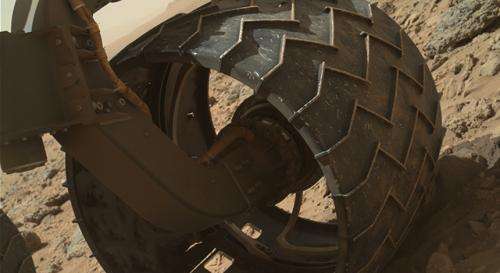Curiosity team upgrades software, checks wheel wear

The team operating NASA's Mars rover Curiosity has completed a software upgrade on the vehicle and is next planning a check of wear and tear on the rover's wheels.
"Curiosity is now operating on version 11 of its flight software," said Jim Erickson of NASA's Jet Propulsion Laboratory, project manager for the NASA Mars Science Laboratory Project, which operates Curiosity.
This is the third upgrade version since Curiosity's landing on Mars16 months ago. Completing the switch from version 10 took about a week. An earlier switch to version 11 prompted an unintended reboot on Nov. 7 and a return to version 10, but the latest transition went smoothly.
These upgrades allow continued advances in the rover's capabilities. For example, version 11 brings expanded capability for using the Curiosity's robotic arm while the vehicle is on slopes. It also improves flexibility for storing information overnight to use in resuming autonomous driving on a second day.
An upcoming activity will be driving to a relatively smooth patch of ground to take a set of images of Curiosity's aluminum wheels, using the Mars Hand Lens Imager (MAHLI) camera at the end of the rover's arm.

"We want to take a full inventory of the condition of the wheels," Erickson said. "Dents and holes were anticipated, but the amount of wear appears to have accelerated in the past month or so. It appears to be correlated with driving over rougher terrain. The wheels can sustain significant damage without impairing the rover's ability to drive. However, we would like to understand the impact that this terrain type has on the wheels, to help with planning future drives."
Curiosity's recent driving has crossed an area that has numerous sharp rocks embedded in the ground. Routes to future destinations for the mission may be charted to lessen the amount of travel over such rough terrain, compared to smoother ground nearby.
NASA's Mars Science Laboratory Project is using Curiosity inside Gale Crater to assess ancient habitable environments and major changes in Martian environmental conditions. JPL, a division of the California Institute of Technology in Pasadena, built the rover and manages the project for NASA's Science Mission Directorate in Washington.
Provided by NASA





















